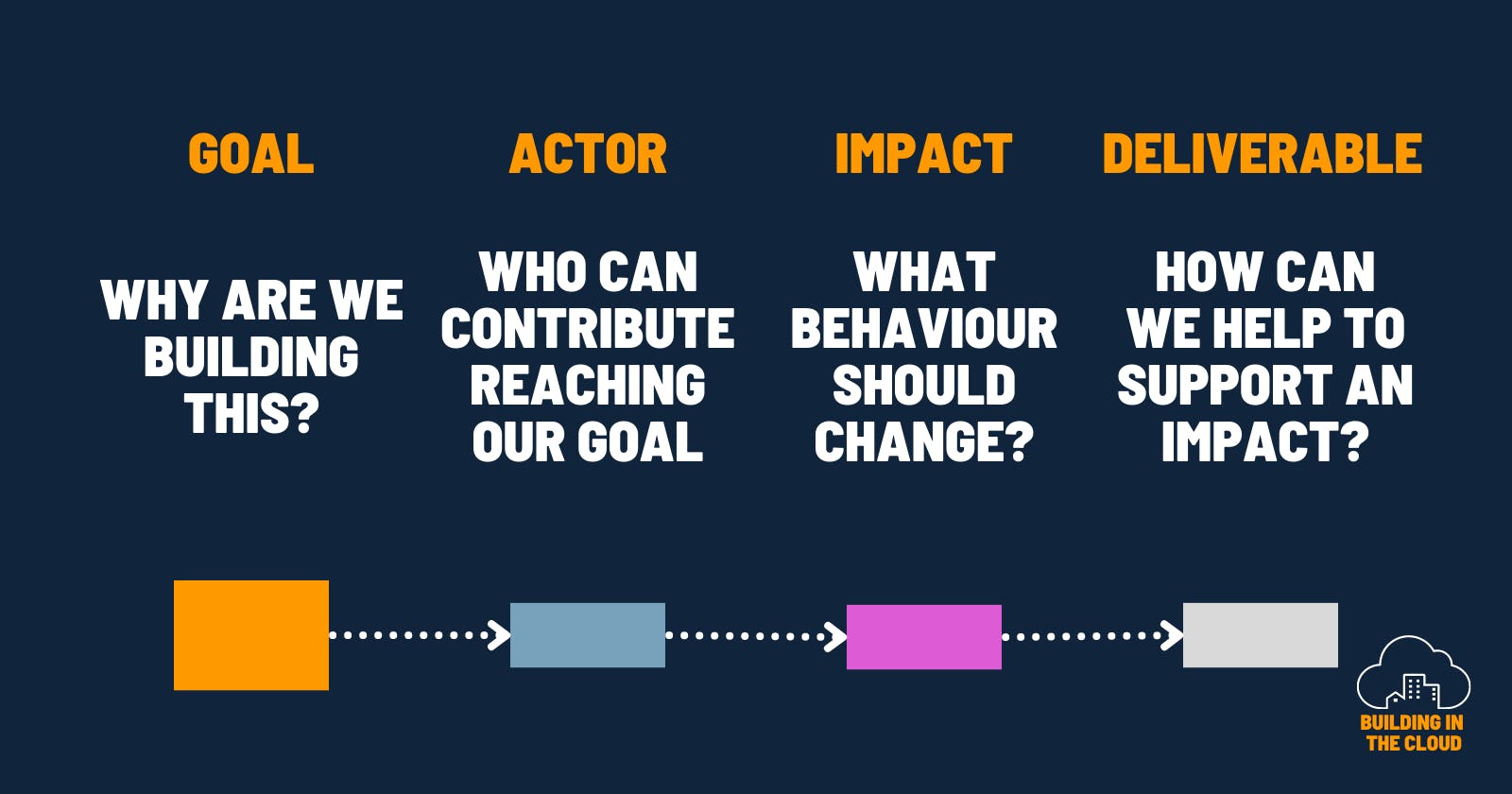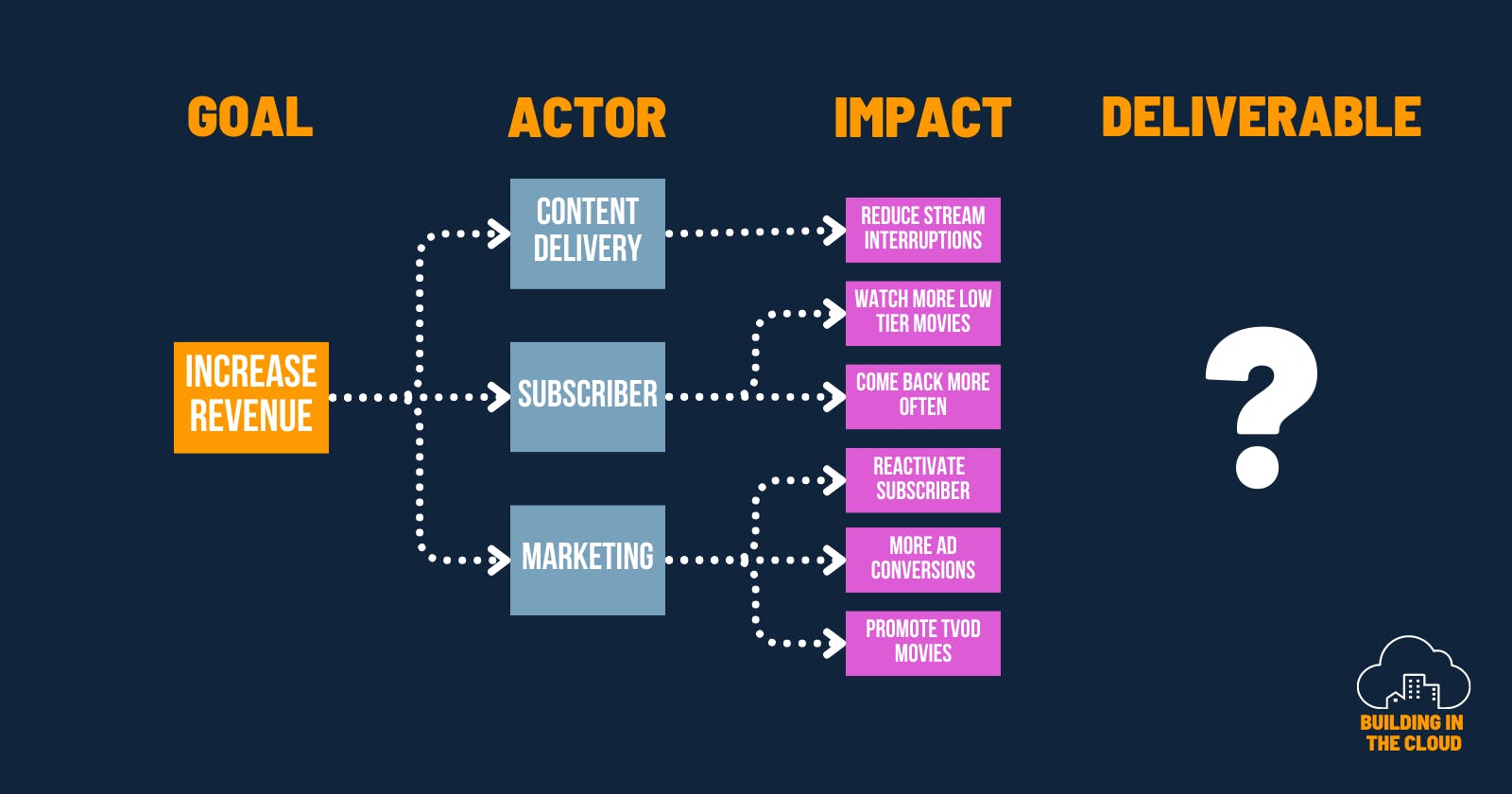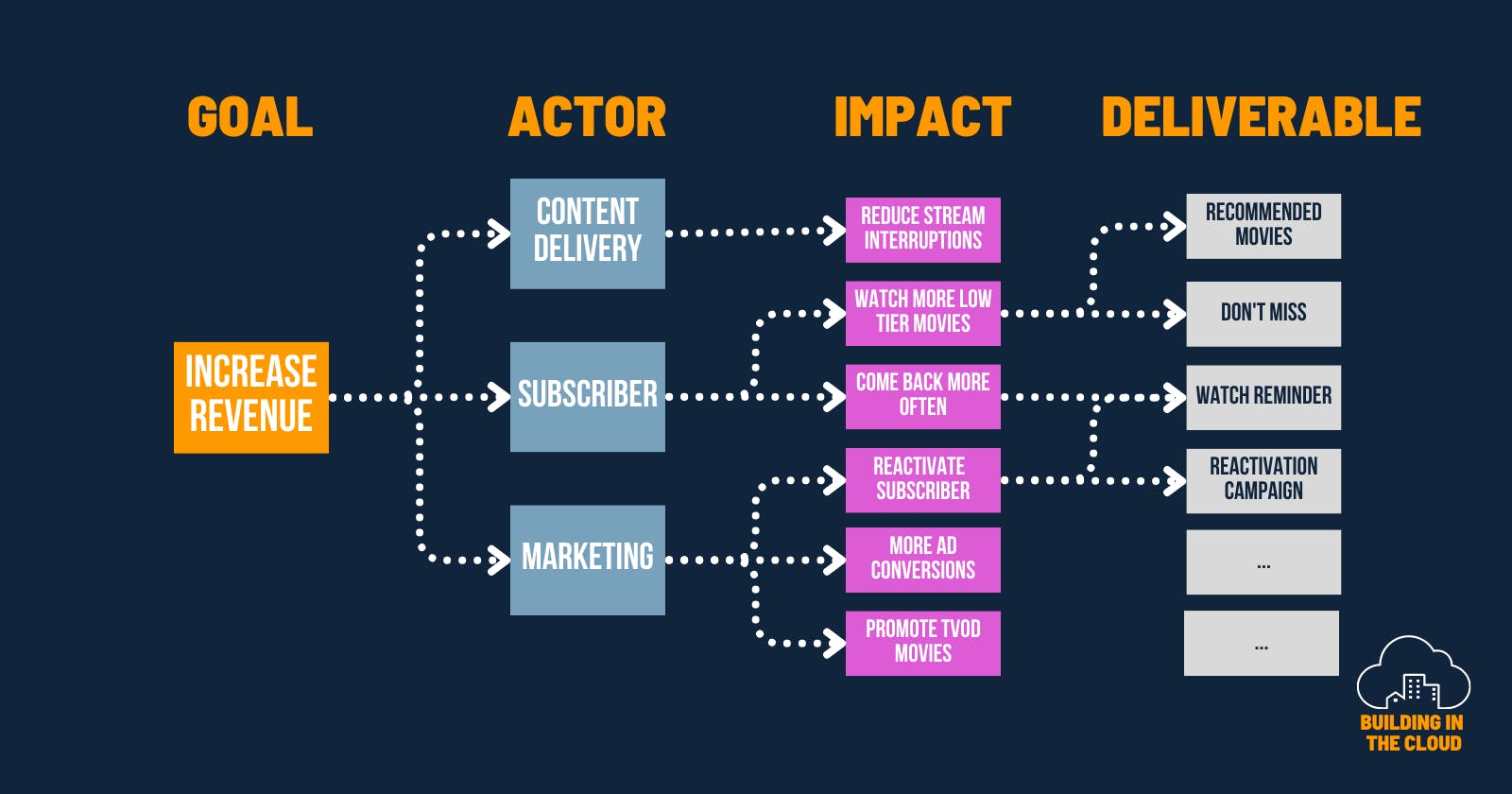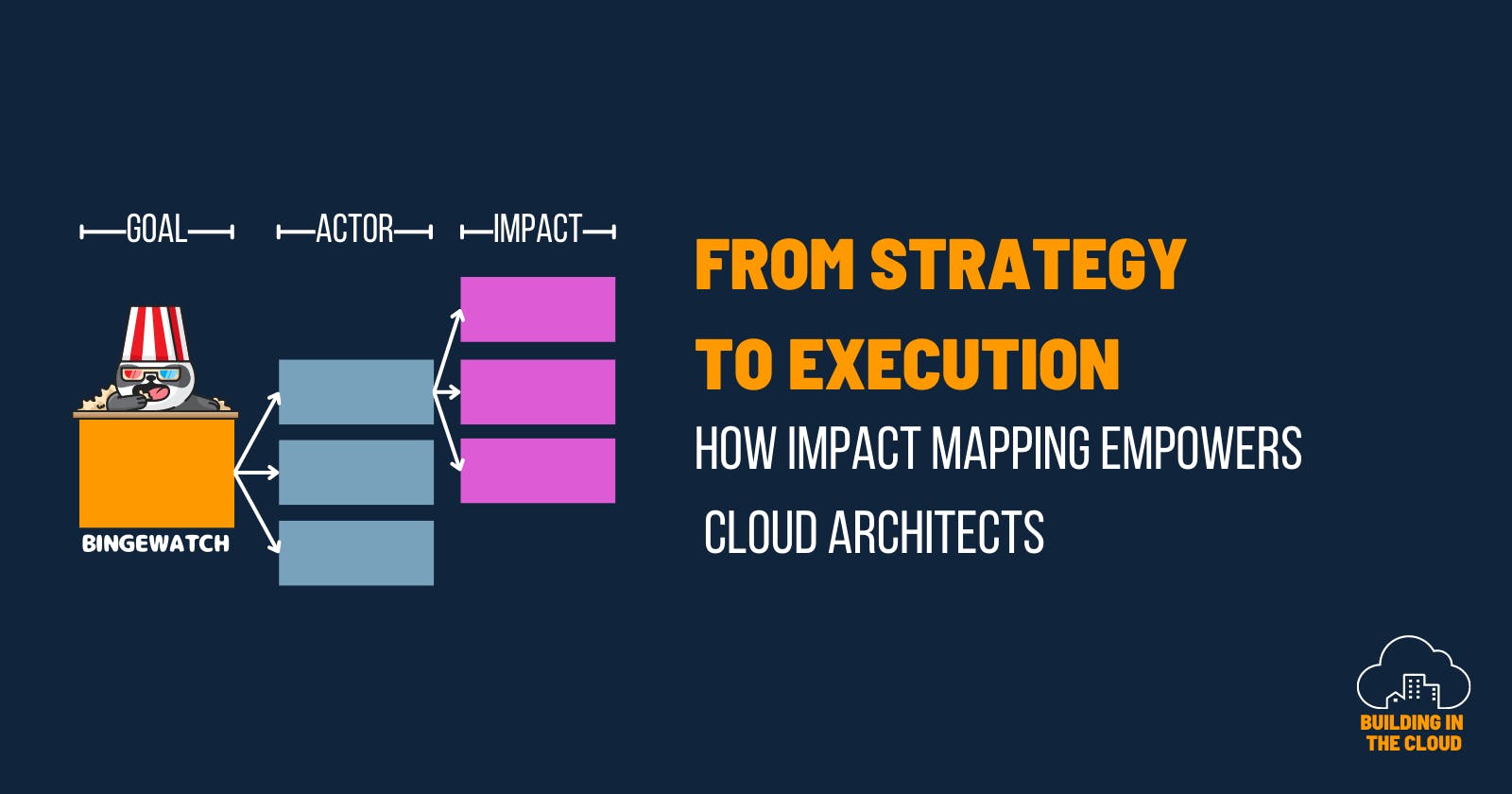Cloud architects play a pivotal role in designing and building scalable and innovative solutions to solve complex business problems. As an AWS Solutions Architect, I understand the challenges that cloud architects face in aligning development teams with overarching business objectives. That's why I'm excited about a powerful visual collaboration method called Impact Mapping that can help to bridge the gap between strategy and execution.
Impact Mapping is a technique that allows cloud architects and development teams to effectively align their activities with the overall business goals. It provides a consistent path from answering "Why are we doing this?" (business goal) to "How can we contribute?" (deliverables). Following this path ensures, that development efforts are directly linked to the desired business outcomes.
In this blog post, we will uncover how Impact Mapping empowers cloud architects in their mission to align development teams with business objectives. We'll explore its significance, discuss a practical scenario, and outline the process of creating an impact map. Additionally, we'll discover how Impact Mapping enables cloud architects to translate business outcomes into measurable KPIs, facilitating a feedback mechanism for development teams to make informed technical decisions.
Are you ready to learn how Impact Mapping can help you overcome these challenges and take your cloud architecture to new heights? Then let's get started!
The importance of aligning development teams with business goals.
We as architects need to connect the dots between IT strategy and business strategy. Aligning development teams with business goals can be a challenge. An impact map acts as a guiding light, enabling us to identify the most impactful deliverables that will bring about the desired changes in customer behavior.
By aligning development teams with business goals, several benefits can be realized. Firstly, it ensures that the efforts of the development teams are directed toward high-priority features that have a significant impact on a common business goal. This focus helps in maximizing the return on investment, optimizing resource allocation, and making a real impact.
Secondly, it fosters a sense of purpose and shared understanding among the team members. When people have a clear understanding of how their work directly contributes to the success of the business, it enhances their motivation and drives them to deliver high-quality solutions.
Understanding Impact Mapping
At its core, impact mapping is typically presented as a mind map or a similar visual hierarchy. It provides a visualized and structured approach to answering fundamental questions such as
Why are we building this? This is the overall goal we are trying to achieve.
Who can contribute to reaching our goal? These are the actors that influence our goal achievement.
How should our customer behavior change? This level connects actors with our goal and defines the impacts we are trying to create.
How can we contribute to support an impact? Deliverables can be software features or organizational activities that focus on making an impact.

By creating an impact map, you establish a clear line of sight between business goals, desired impacts, and deliverables. The beauty of impact mapping lies in its simplicity and ease of use.
It not only provides a visual representation of the alignment between technical decisions and business outcomes, but it also serves as a communication tool that facilitates collaboration and shared understanding among all stakeholders. This shared understanding is crucial for making informed decisions, prioritizing features, and optimizing resource allocation.
Creating an impact map for Bingewatch
To illustrate the practical application of impact mapping, let's dive into a scenario involving a fictitious company called Bingewatch - a leading VOD platform. Bingewatch faces the challenge of maintaining customer engagement and preventing churn as customers increasingly gravitate toward competitors. As the financial situation is very tense, the CEO of Bingewatch has decided to address this issue by calling out a business goal to increase revenue.
As a cloud architect supporting Bingewatch's development teams, your role is crucial in aligning their efforts with the overarching business goal of increasing customer engagement. Every team has a lot of great ideas and a huge amount of stories in their backlog. But how should our teams start? You start by creating an impact map, to guide the selection of the right features that will have a tangible impact on achieving this goal.
Level 1: Identify the Business Goal
This part is easy as the business goal was clearly articulated by the CEO. This will be the first level and starting point of our map.

If you are in a situation where the business goal is not that clear like in this case, ensure to define a goal that focuses on the problem that needs to be solved instead of describing the solution. Focus on the outcome, not on the output!
Level 2: Identify the Actors
The team identified three relevant actors that impact the desired outcome of Bingewatch.
Subscriber: Paying customers that use Bingewatch to watch movies, series, and TV shows.
Marketing Team: The team responsible for promoting Bingewatch and its content and special offerings.
Content Delivery: Systems responsible for delivering high-quality video streams to subscribers all over the world.

Subscribers are our primary actors whose needs are already fulfilled. The Marketing Team and the Content-Delivery Team are secondary actors that provide services, facilitating the fulfillment of our primary actors' needs.
Level 3: Define Impacts
This level defines for each actor how their behavior should change to support our goal. Subscribers should be encouraged to visit the platform more often and watch more movies during their customer lifetime.
Our Marketing Team should promote new videos to create awareness and interest in several movies. These can be both new videos, special offers, or videos that are top-ranked in certain markets and territories.
Also, more technical teams like our Content-Delivery Team can contribute to our business goal. They should ensure that subscribers get a best-in-class movie experience by minimizing streaming errors and disruptions - one of the top 3 reasons for customers to cancel their subscriptions.

Level 4: Map Deliverables
Level 4 leaves a lot of room for creativity - but in a controlled and safe place ensuring that only software features or activities are considered that provide the change in behavior of an actor and therefore support our business goal.
By sending out reminder notifications, inactive subscribers should be reactivated to continue watching unfinished movies or series. Active subscribers should be able to set a reminder for new season launches of their favorite series. An "don't miss" feature should send out a notification to subscribers once new movies of favorite actors or genres of a subscriber are added to the catalog.
Providing recommended movies to watch on the home screen should help to influence the impact of more movie watches per subscriber. The team assumes that related content in the content discovery screen (Because you watched movie ABC) or similar movie recommendations on the detail page (More like ABC) will increase the number of watched movies per subscriber over time.

This is just an excerpt of deliverables and the final list might be longer than the one you see here. During the discovery phase, there will be also ideas that are great but are not related to the behavior change of the actors and the business goal. By mapping the deliverables to the impacts, the development teams at Bingewatch can prioritize their efforts and focus on building features that will have a direct impact on increasing subscriber engagement.
Making Roadmap Decisions and Aligning Backlogs
Once the impact map is created, it's essential to translate the identified business outcomes into measurable Key Performance Indicators (KPIs). KPIs provide a quantifiable way to assess the success of the impact map and track progress toward achieving the desired business goals.
In our Bingewatch example, the business goal was clearly articulated. But how do we know that we achieved our goal? We can define KPIs and metrics such as:
The number of returning subscribers: This metric indicates the success in attracting subscribers to revisit the platform, demonstrating sustained engagement.
Average movies watched per subscriber per month: By tracking the number of movies each subscriber consumes within a given time frame, we can gauge the level of engagement and whether subscribers are actively using the platform.
Customer lifetime value: The longer customers stay as active and engaged subscribers the more revenue will be created. A key KPI for Bingewatch.
Reduced stream errors: This metric reflects the quality of the streaming experience. By aiming to minimize stream errors, we enhance user satisfaction and encourage continuous usage.
Subscriber churn: The fewer people leave (for example due to reduced streaming errors) the higher the customer lifetime value.
By setting these KPIs and metrics, cloud architects and development teams have clear performance indicators that will help evaluate the impact of their initiatives. Regularly monitoring these metrics provides valuable insights into the effectiveness of the solutions being developed and allows for adjustments to be made to the roadmap if necessary.
Impact mapping serves as an excellent starting point for creating agile roadmaps and backlogs that align with business goals. It provides a framework for prioritizing features and functionalities based on their impact on the desired business outcomes.

When translating the impact map into a backlog, the focus shifts to defining user stories and tasks that support the delivery of the mapped deliverables.
Conclusion: Build with impact
In conclusion, impact mapping empowers cloud architects to connect the dots, building solutions that make a real impact on the business. The beauty of impact mapping lies in its simplicity and effectiveness. It provides a visual collaboration method that bridges the gap between strategy and execution, enabling cloud architects to translate business outcomes into deliverables and establish a feedback loop through measurable KPIs.
Integrating impact mapping into the backlog design and discovery process can enhance the alignment between development teams and business objectives. It enables you to create roadmaps and backlogs that are focused on building solutions that make a tangible impact toward the common business goal.
So, why not give impact mapping a try? Start by identifying the business goals, actors, impacts, and deliverables relevant to your specific context. Collaborate with stakeholders to create an impact map that aligns development teams with the overall business objectives. Use it as a guide to prioritize features, make roadmap decisions, and create backlogs that focus on building solutions with a measurable impact.
Remember, impact mapping is a flexible and iterative process. As you gather feedback and measure the success of your solutions, continue to refine and adjust your impact map accordingly. This ensures that you stay aligned with evolving business goals and adapt to changing market demands.
By incorporating impact mapping into your cloud architecture practice, you can enhance your ability to drive business outcomes, foster collaboration among teams, and deliver solutions that truly make an impact on your organization's success.

